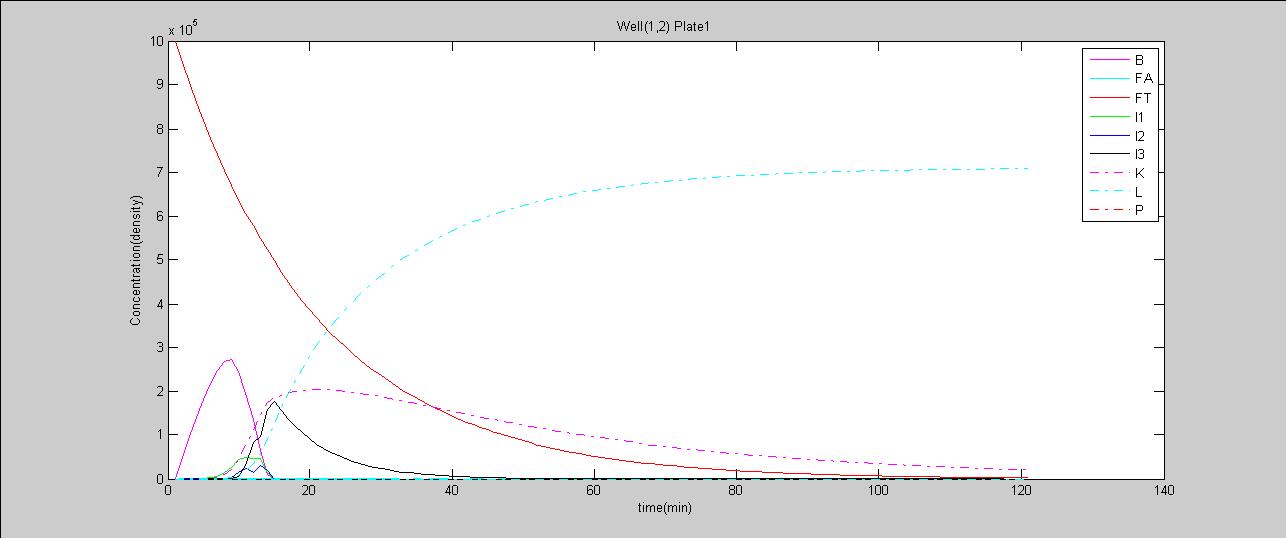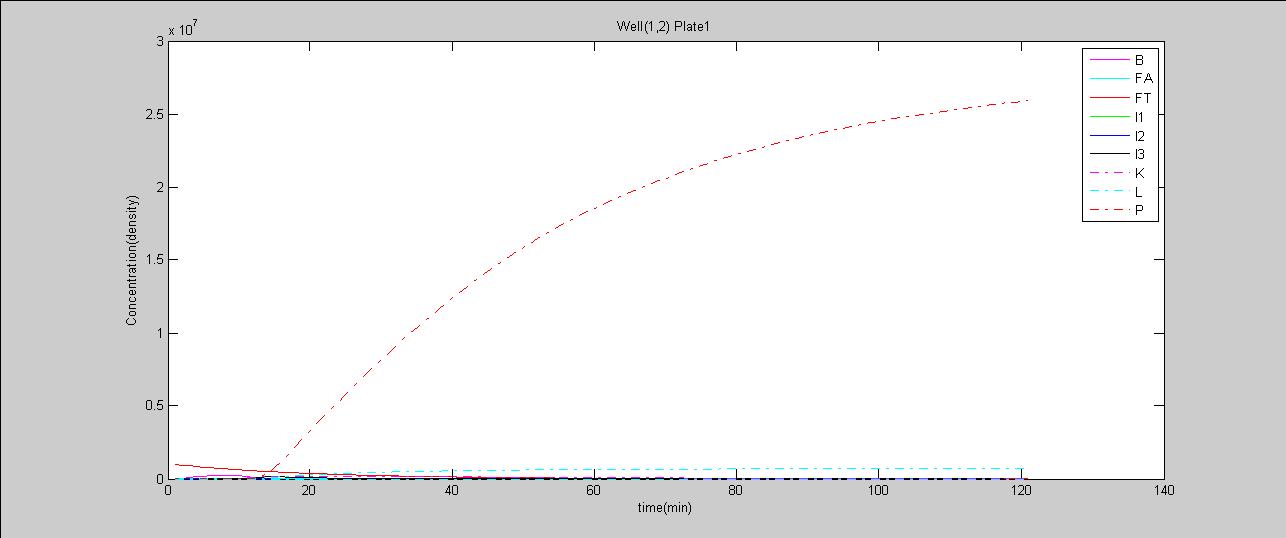Virginia Tech/pre model
From 2007.igem.org
(Difference between revisions)
BlairLyons (Talk | contribs) m |
BlairLyons (Talk | contribs) m |
||
| Line 72: | Line 72: | ||
| style="padding: 20px; background-color: #FFFFFF;" | | | style="padding: 20px; background-color: #FFFFFF;" | | ||
| + | <h3>Our preliminary model was our first attempt at modeling an infection in a single population.</h3> | ||
| + | Once we generated experimental data later in the summer, we revised it significantly. Here is a summary of our original approach using reaction equations, the hybrid simulator, and our toolkit. | ||
| + | [[Image:Model2_all.jpg|thumb|right|500px|'''A graph generated by the simulator''' zoomed in on all species except phage, which grows on a much larger scale than other species]] | ||
| - | + | [[Image:Model2_phage.jpg|thumb|right|500px|'''All species in one infection reaction''' As the phage (P) infects the uninfected bacteria (B) the amount of uninfected cells decline and number of lysogenic (L) and lytic (K) cells increase. As the lytic cells burst and release phage into the environment, the number of lytic gradually decline and the number of phage quickly increase.]] | |
| - | + | <h3>The Model</h3> | |
| - | + | ||
| - | + | ||
| - | + | ||
| - | + | ||
| - | + | ||
| - | + | ||
| - | + | ||
| - | + | ||
| - | + | ||
| - | + | ||
| - | + | ||
| - | + | ||
| - | + | ||
| - | + | ||
| - | < | + | '''Reactions:''' |
| + | |||
| + | '''Rxn_1:''' B + P --> I1 [200]<br> | ||
| + | '''Rxn_2:''' I1 + P --> I2 [200]<br> | ||
| + | '''Rxn_3:''' I2 + P --> I3 [200]<br> | ||
| + | '''Rxn_4:''' I1 --> L [6.667000e-002]<br> | ||
| + | '''Rxn_5:''' I1 --> K [6.000000e-001]<br> | ||
| + | '''Rxn_6:''' I2 --> L [6.667000e-002]<br> | ||
| + | '''Rxn_7:''' I2 --> K [1.555600e-001]<br> | ||
| + | '''Rxn_8:''' I3 --> L [6.667000e-002]<br> | ||
| + | '''Rxn_9:''' I3 --> K [6.667000e-002]<br> | ||
| + | '''Rxn_10:''' K --> 100P [2.500000e-002]<br> | ||
| + | '''Rxn_11:''' B + FA --> 2B [5.000000e-002]<br> | ||
| + | '''Rxn_12:''' L + FA --> 2L [5.000000e-002]<br> | ||
| + | '''Rxn_13:''' FT --> FA [5.000000e-002]</p> | ||
| + | |||
| + | |||
| + | '''InitialValues:''' | ||
B=10000<br> | B=10000<br> | ||
P=100<br> | P=100<br> | ||
FT=1.000000e+006</p> | FT=1.000000e+006</p> | ||
| - | |||
| - | |||
| - | |||
| - | |||
| - | |||
| - | |||
| - | |||
| - | |||
| - | |||
| - | |||
| - | |||
| - | |||
| - | < | + | '''The Species:''' |
| + | B = uninfected bacteria<br> | ||
| + | P = phage | ||
| + | I = intermediate stage | ||
| + | K = lytic ''E. coli'' | ||
| + | L = lysogenic ''E. coli'' | ||
| + | FT and FA = food | ||
| + | '''How the model works''' | ||
| + | The first reaction represents a phage infecting a bacterial cell. When the cell becomes infected, it can either turn lytic or lysogenic. This decision is based on environmental factors surrounding the bacterial cell. If there is an excess of phage in the environment, an infected ''E. coli'' has a high probability of becoming lysogenic; however, if there is a scarcity of phage viruses surrounding the bacterial cell, there is a high probability that the cell will become lytic. The intermediate I is used to control the probabilities surrounding this decision. The growth of the bacteria and lysogenic cells are limited by available food so that the cells don't grow unhindered. | ||
|}<html></center></html> | |}<html></center></html> | ||
Revision as of 01:14, 25 October 2007
|
|








